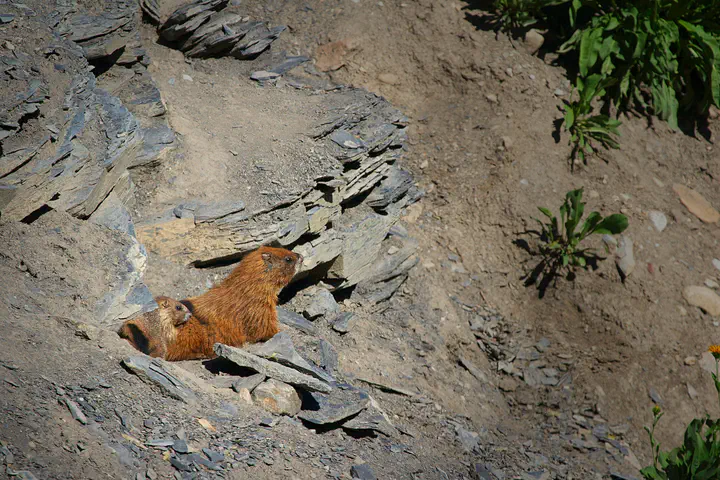Research projects
 Photo by J Martin
Photo by J Martin
Main projects
Senescence in yellow-bellied marmots
The focus of this project is to teae apart age-dependent and age-independent effects of senescence and determine their interactions with environmental conditions.
Evolution and environmental change in yellow bellied marmots
am interested in the impact of climate changes on the evolution of traits of yellow-bellied marmots. More specifically I will use a quantitative genetic approach to study changes in traits & distribution and variance due to changes in the environment
Research methods
Long-term monitoring
Long-term studies are the best way to track changes in the environment and quantify their consequences for population dynamics and fitness consequences of quantitative phenotypic traits, two key components of understanding the impacts of climate change. Although I highly value this approach to study ecological and evolutionary questions, it provides results that are correlative and not causative as one could obtain with an experiment. On the other hand, experimentation on life-history trade-offs or selection in the wild are nearly impossible when studying long-lived animals.
Unmanned Aerial Vehicles (UAVs)
UAVs offer the ability to collect new data non-invasively, and quite rapidly over a small to medium scale of the environment. I am mainly using aerial mappinig type of data to estiamte habitat quality and size, identity animals at the individual level and precisely map them. If a flight could fairly be quick, the post-processing of the data collected could be gigantic.
Statistics
- mixed model
- animal model
- random regression
- double hierarchical model
- path analysis
- social network analysis
- geostatistical analysis
Past projects
Orangutan Nest Watch
We fly drones over an area of Forest in Sabah, Malaysian Borneo in order to find out how orangutans are affected by human impacts on their environment. Orangutans are Critically Endangered and it is vital to protect their remaining habitat. However we do not yet know at what population densities they live, so we need to search through each individual photo to see if we can find their nests and their vital food source- strangler fig trees. The more we know about the habitat orangutans can survive in, the more we can build to protect suitable areas of forest where they can live into the future, and reduce the threat of local extinction. Find out more at project site but more importantly volunteer and help us by participating on the Zooniverse project
Spatial and social structure at harbour seal haul-out sites using Unmanned Aerial Vehicles (UAVs)
I am interested in the social structure and spatial distribution of seals at haul out sites. Due to heavy logistics, simple data such as individual body condition, distance between neighbours and identity of neighbour are rarely known in seal studies. Using UAVs, I am able to measure, identity and map precisely seals hauling out. I am looking at stabilty of social structure throughout the seasons and years, as well as habitat selection at small scale for haul out site.
Personality in long-lived fulmars and its impact on foraging strategies and reproduction
Using a long-term study of fulmars at Eynhallow, Orkney Islands, UK, I am looking at the between individual variation in docility and agressiveness and their consequences on reproductive output.
Reproductive strategies of Bighorn ewes
For my PhD, I worked on reproductive strategies of bighorn sheep females with Pr. Marco Festa-Bianchet. I was interested in how adult females allocate energy to reproduction or to survival under different conditions. In few words, bighorn females always favor their own body condition and survival over the ones of their lambs.
Personality in wild eastern chipmunk
I have done my M.Sc on personality in wild chipmunks under the supervision of Pr. Denis Réale. My main interest was to establish if individuals differed in their behaviour in a stressful situation and how these differences were related to hormones and human disturbance